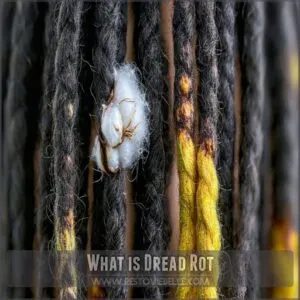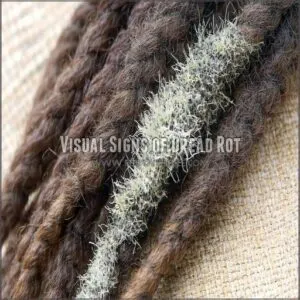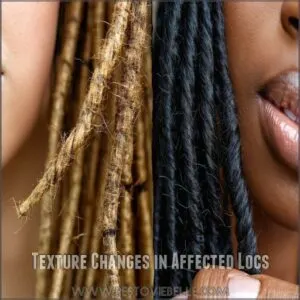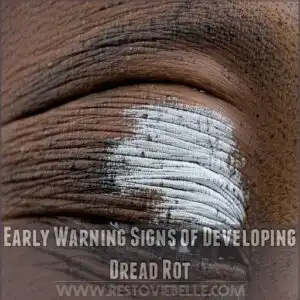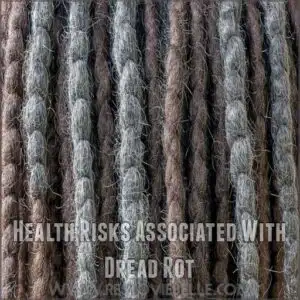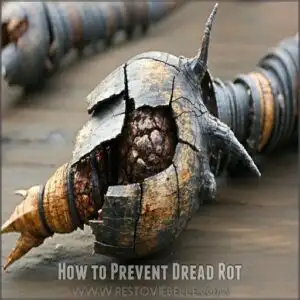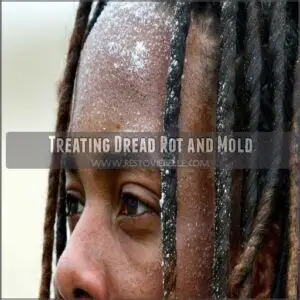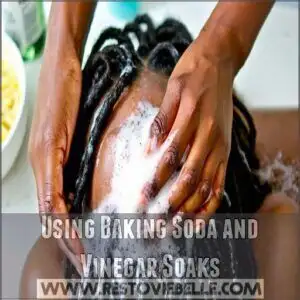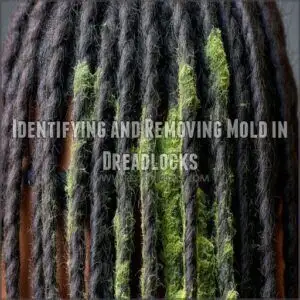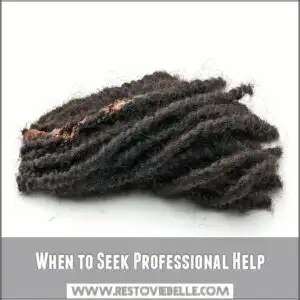This site is supported by our readers. We may earn a commission, at no cost to you, if you purchase through links.

This sneaky condition happens when moisture gets trapped inside your dreads, creating a perfect environment for mold and mildew.
Think of it as your locs throwing an unwanted house party for fungi.
You’ll notice warning signs like musty odors, discoloration, or a spongy texture.
While it might sound scary, you’re not powerless against this common nemesis.
With the right knowledge and care routine, you can keep your locs healthy and fresh.
There’s more to this story than meets the eye—from prevention strategies to rescue remedies.
Table Of Contents
- Key Takeaways
- What is Dread Rot
- What Causes Dread Rot
- Signs and Symptoms of Dread Rot
- Health Risks Associated With Dread Rot
- How to Prevent Dread Rot
- Treating Dread Rot and Mold
- Deep Cleansing and Rinsing Techniques
- Lifestyle Changes to Combat Dread Rot
- Identifying and Removing Mold in Dreadlocks
- When to Seek Professional Help
- Frequently Asked Questions (FAQs)
- What is dread rot?
- What is Dreadlock rot?
- How do you know if you have dread rot?
- Does dread rot damage hair follicles?
- How do I know if my dreadlocks are rotting?
- Does dread rot cause mold growth?
- What is dread rot?
- How do you fix moldy dreads?
- Does mold grow in dreadlocks?
- How to get rid of dread rot on Reddit?
- Can dread rot spread to other peoples hair?
- How long does it take to fully treat dread rot?
- Will dread rot eventually go away on its own?
- Does hair color or texture affect dread rot risk?
- Can protective hairstyles prevent dread rot from returning?
- Conclusion
Key Takeaways
- You can prevent dread rot by washing your locs every 2-3 weeks with a residue-free shampoo and drying them thoroughly. Don’t let them stay damp.
- If you notice a musty odor, discoloration, or spongy texture in your locs, you’ve likely got dread rot. Address it immediately.
- To treat mild dread rot, deep cleanse your locs with a baking soda and vinegar soak, followed by a clarifying shampoo. For severe cases, see a professional.
- Maintaining good hygiene, managing stress, and eating a healthy diet can all contribute to preventing dread rot and promoting healthy locs.
What is Dread Rot
Your dreadlocks can become a cozy home for fungi when trapped moisture and product buildup create the perfect breeding ground for what’s known as dread rot.
Just like that forgotten sandwich in the back of your fridge, your locs can develop an unwanted fuzzy visitor that causes damage and that unmistakable mildew smell.
Definition and Explanation
Picture your dreads as a thriving garden – but when dread rot strikes, it’s like unwanted fungus taking over.
Dread rot is a serious condition where fungal growth and microbial contamination develop inside your locs.
Think of it as your dreads’ worst enemy: it damages your hair from within and can irritate your scalp.
To help prevent this, you should use the right products, such as those found in a Dread rot treatment solution.
Left unchecked, it’ll turn your beautiful locs into a breeding ground for trouble.
Causes of Dread Rot
Several sneaky factors can conspire to create the perfect environment for dread rot in your locs.
Think of your dreads like a sponge – they’re excellent at soaking up and holding onto moisture.
If you’re not careful, this moisture can also contribute to other issues, such as scalp infections like seborrheic dermatitis, which can slow hair growth.
Here’s what’s usually behind this pesky problem:
- Improper drying after washing or swimming
- Using heavy products that trap moisture
- Living in humid environments without proper protection
Remember, prevention beats cure!
Effects of Dread Rot on Hair
Those pesky fungi from moisture buildup don’t just camp out in your locs – they’re secretly wreaking havoc on your hair’s structure.
Your once-strong locs can become vulnerable battlegrounds where fungi wage war on your hair’s integrity.
| Effect Stage | Internal Impact | External Signs | Health Risk |
|---|---|---|---|
| Early | Cuticle softening | Slight frizz | Low |
| Developing | Protein breakdown | Loc loosening | Moderate |
| Advanced | Cortex damage | Thinning spots | High |
| Severe | Complete degradation | Loc separation | Critical |
What Causes Dread Rot
Your dreadlocks can become a breeding ground for mold and bacteria when you don’t dry them properly after washing or let product buildup trap moisture inside.
Dread rot can flourish in humid climates or when using heavy products like wax.
Excessive Moisture Retention
Moisture lurks in your locs like a silent enemy, ready to trigger dread rot when you least expect it.
Think your dreads are safe? Your hair’s natural porosity combined with environmental factors can trap dampness deep within, creating the perfect breeding ground for fungal growth.
- Your once-bouncy locs feel heavy and waterlogged after washing
- Humid days leave your scalp feeling uncomfortably damp
- Your dreads take more than 24 hours to dry completely
Improper Dreadlock Care
Your daily dreadlock care routine could be silently sabotaging your locs, especially if you’re not addressing dandruff causes like yeast overgrowth, which can be managed through proper scalp care techniques. Your daily dreadlock care routine could be silently sabotaging your locs.
Poor maintenance practices lead to weak, vulnerable hair that’s prone to rot.
Here’s what you need to know:
| Issue | Impact | Solution |
|---|---|---|
| Overwashing | Strips natural oils | Wash every 2-3 weeks |
| Improper drying | Trapped moisture | Use microfiber towel |
| Tight styling | Root damage | Loose, gentle styles |
Remember: Your locs need a balanced approach – not too much attention, not too little.
Residue Buildup Issues
Improper product choices can turn your locs into a magnet for trouble.
Think of residue buildup like a cozy blanket for bacteria – it traps moisture and creates the perfect environment for dread rot.
Waxes, heavy oils, and non-residue-free shampoos leave behind a sticky film that’s hard to remove.
Want to stay safe? Stick to lightweight, residue-free products and deep cleanse regularly to keep those locs fresh and healthy.
High Humidity Environments
Living in a humid climate can turn your locs into a moisture trap.
Think of your dreadlocks as tiny sponges – they’ll soak up that heavy air like nobody’s business.
When humidity levels spike above 60%, you’re basically giving mold a VIP pass to your hair party.
Keep an eye on those weather forecasts and take extra precautions during muggy seasons to protect your locs from becoming a mold magnet.
Signs and Symptoms of Dread Rot
You’ll know your locs are in trouble when they start smelling like your gym bag after a week-long vacation and feel fuzzy or discolored in spots.
Once you notice these tell-tale signs, you’re dealing with dread rot, but don’t worry – we’ll show you exactly how to tackle this common problem head-on.
Visual Signs of Dread Rot
Spotting dread rot early can save your locs from serious damage.
Watch for discoloration that turns your dreads from their natural shade to dull gray or greenish tints.
You might notice fuzzy white patches forming along the length of your locs, especially near the roots.
The texture may become unusually soft or mushy in affected areas, and you’ll likely see increased hair breakage or thinning.
Unpleasant Odors Associated With Dread Rot
A musty, unpleasant odor wafting from your locs could be your first warning sign of dread rot.
Think of it as your hair’s emergency alarm system trying to get your attention.
Here’s what your nose might detect:
- A damp, mildew-like smell similar to forgotten laundry
- That distinct wet dog aroma that won’t quit
- A musty, basement-like scent that lingers even after washing
Texture Changes in Affected Locs
Beyond the telltale smell, your locs will physically change when dread rot takes hold. You’ll notice these texture changes that signal trouble:
| Warning Sign | What It Means |
|---|---|
| Soft & Spongy | Moisture trapped inside |
| Brittle & Breaking | Internal structure damage |
| Slimy & Sticky | Active mold growth |
Think of these changes like your locs sending an SOS signal – they’re literally crying out for help.
Don’t ignore these physical transformations, as they’re clear indicators that something’s wrong inside your locs.
Early Warning Signs of Developing Dread Rot
While texture changes can be subtle, catching dread rot early means watching for these telltale signs.
Your locs might feel slightly damp even hours after washing, or you’ll notice a faint musty smell that wasn’t there before.
Keep an eye out for white or gray patches, especially near your roots.
If your scalp feels itchy or your locs seem heavier than usual, don’t wait – act fast.
To prevent dread rot, consider investing in products from a reliable Dread Rot Prevention store.
Health Risks Associated With Dread Rot
You’ll want to take dread rot seriously since it can lead to painful scalp infections and trigger allergic reactions that’ll have you scratching like there’s no tomorrow.
Beyond the uncomfortable itching and potential hair loss, untreated dread rot can cause lasting damage to your scalp and even impact your confidence when those musty odors start turning heads for all the wrong reasons.
Scalp Infections From Untreated Dread Rot
A neglected case of dread rot can turn your scalp into a breeding ground for serious infections.
When moisture-loving fungi and bacteria set up camp under your locs, they can trigger painful scalp sores, inflammation, and even hair loss.
Don’t let these unwanted guests make themselves at home – proper dreadlock hygiene is your first line of defense against these stubborn scalp invaders.
Allergic Reactions to Mold in Locs
Anyone can develop mold sensitivity in their locs, even if you’ve never had allergies before.
Mold spores can trigger breathing issues if you’re dealing with asthma.
When mold takes hold, you might notice itchy eyes, sneezing fits, or that telltale tickle in your throat.
Don’t take chances with your health; anti-mold shampoos and regular maintenance can keep those allergens at bay.
Long-term Hair Damage From Rot
Mold spores from dread rot silently wage war on your hair’s structure, leading to permanent damage that goes beyond surface level.
The fungi break down keratin proteins, causing your locs to thin and weaken at the roots.
You’ll notice split ends, breakage, and even patches of hair loss where damaged follicles can’t support healthy growth anymore.
Left unchecked, dread rot can destroy entire sections of your locs.
Psychological Impact of Severe Dread Rot
Physical damage from dread rot can hit your confidence hard.
Living with visible mold or that unmistakable musty smell can trigger social anxiety, making you hesitant to get close to others.
You might find yourself canceling plans or avoiding social gatherings, worried about judgments or embarrassing comments.
This isolation often leads to a dip in self-esteem, especially when you’re constantly self-conscious about your locs’ appearance.
How to Prevent Dread Rot
You don’t need to play detective with your locs to spot dread rot – preventing it’s much easier than treating it.
Just like you wouldn’t leave a wet towel bundled up for days, to prevent this, understand how often to wash dreads, you’ll want to keep your locs clean and dry with proper washing techniques and thorough drying methods.
Proper Washing Techniques for Locs
Keeping your locs clean doesn’t have to feel like rocket science.
Wash them every two weeks with a sulfate-free, residue-free shampoo at lukewarm temperature – hot water can cause frizz, while cold water won’t remove buildup effectively.
For new locs, it’s recommended to wash them daily, and for mature locs, every 7-10 days, as part of a regular dreadlock washing schedule.
Gently massage your scalp and locs, working the shampoo through each one.
Skip the wax products and opt for water-based gels instead to prevent that dreaded buildup.
Effective Drying Methods to Prevent Moisture Buildup
After washing your locs, proper drying isn’t just important—it’s essential for preventing that dreaded dread rot.
Here are five proven methods to keep your locs moisture-free:
- Use a microfiber towel to gently squeeze out excess water
- Position a fan nearby for continuous airflow
- Sit in natural sunlight for 30-45 minutes
- Set your hairdryer to low heat, moving constantly
- Sleep with a silk pillowcase to prevent overnight moisture
Balancing Moisturizing and Drying of Locs
Proper moisture balance can make or break your locs’ health.
Your goal? Finding that sweet spot between too dry and too damp.
Here’s a quick guide to master moisture management:
| Action | What to Do | What to Avoid | Warning Signs | Solution |
|---|---|---|---|---|
| Washing | Every 2 weeks | Daily washing | Heavy locs | Space out washes |
| Products | Water-based gels | Heavy oils, wax | Product buildup | Switch to lighter options |
| Drying | Air dry completely | Sleeping wet | Musty smell | Use a fan or dryer |
| Environment | Control humidity | Humid spaces | Damp roots | Dehumidifier nearby |
| Moisture Check | Palm test | Guess work | Squishy locs | Wait to style |
Regular Scalp Checks and Maintenance
You’re in control of your loc health when you make scalp checks part of your weekly routine.
Get up close with a mirror and examine your scalp for any redness, flaking, or unusual spots.
Run your fingers along your roots, checking for tenderness or buildup.
Don’t skip those hard-to-see spots at the back – use a handheld mirror to catch every angle.
Treating Dread Rot and Mold
You’ll be happy to know that dread rot isn’t a death sentence for your locs, and with the right treatment plan, you can kick that unwanted fungal roommate to the curb.
Whether you’re dealing with a minor case or a full-blown mold invasion, we’ve got the battle-tested solutions that’ll help restore your locs to their former glory.
Deep Cleansing Techniques for Affected Locs
Deep cleansing your affected locs takes skill and patience – think of it as giving your hair a spa day!
Here’s your power move against dread rot:
- Mix 1/4 cup baking soda per gallon of warm water and soak locs for 15 minutes
- Gently squeeze each loc while soaking to release trapped debris
- Follow with a clarifying shampoo rinse, working from roots to tips
Remember: murky water means it’s working!
Natural Remedies to Combat Dread Rot
When dread rot strikes, your kitchen cabinet might hold the solution.
Mix apple cider vinegar (1 cup) with baking soda (½ cup) in warm water for a powerful natural cleanse.
To minimize dread rot, using nourishing oils like those discussed in best oil for dreads is key, as they help to moisturize and condition your hair and scalp. Tea tree and lavender oils add extra antimicrobial punch – plus, they’ll make your locs smell amazing.
For stubborn spots, try a rosemary-infused coconut oil treatment or aloe vera gel to soothe your scalp and fight fungal growth.
Professional Treatments for Severe Cases
Natural remedies not cutting it? Professional help might be your best bet.
A certified trichologist can provide specialized treatments that target severe dread rot cases:
- Deep cleansing protocols using medical-grade antifungal solutions
- Advanced microscopic analysis to identify specific fungal strains
- Customized treatment plans based on your loc’s unique condition and severity
Think of trichologists as loc doctors – they’ve got the tools and expertise to tackle even the most stubborn cases of dread rot.
Repairing Damaged Locs After Rot Removal
Taking back control of your locs after rot removal starts with gentle care.
Focus on strengthening treatments using pure aloe vera gel and organic coconut oil to nourish weakened strands.
You’ll want to retwist carefully, avoiding tight tension that could stress fragile sections.
Space out your maintenance sessions every 6-8 weeks, giving your locs time to regain their strength and natural pattern.
Deep Cleansing and Rinsing Techniques
You’ll need more than just your regular wash routine to kick dread rot to the curb, and we’ve got the deep-cleaning techniques that’ll make your locs feel fresh as morning dew.
Let’s explore these powerful cleansing methods that’ll give your dreadlocks the spa day they deserve, using simple ingredients you probably already have in your kitchen.
Using Baking Soda and Vinegar Soaks
Banish dread rot with a potent baking soda and vinegar soak – your locs’ secret weapon against buildup and funk.
Mix 1/2 cup baking soda with 1 cup apple cider vinegar in 2 gallons of warm water.
Here’s what this power combo does for your locs:
- Balances scalp pH levels naturally
- Dissolves stubborn residue and oils
- Kills fungus and bacteria
- Leaves locs feeling fresh and clean
Soak for 15 minutes, then rinse thoroughly.
Clarifying Shampoos for Dreadlocks
For a gentle and sulfate-free cleanse, consider a formula with natural ingredients like tea tree oil as found in the best clarifying shampoo for locs. While baking soda and vinegar work wonders, your choice of clarifying shampoo can make or break your loc journey.
Look for sulfate-free formulas specifically designed for dreadlocks – they’ll strip away buildup without leaving residue behind.
Your best bet? Rotate between a gentle daily cleanser and a deep-cleaning clarifying shampoo every two weeks.
Just remember: residue-free doesn’t mean stripping your locs bone-dry.
Essential Oils for Fragrance and Hygiene
Your locs deserve more than just any old fragrance – they need the protective power of essential oils.
Tea tree, lavender, and peppermint oils don’t just make your locs smell amazing; they’re natural warriors against bacteria and fungi.
They can even be used for natural hair removal methods.
Mix 15-30 drops with your cleansing solution for a spa-worthy treatment that’ll keep your locs fresh and healthy.
Think of it as aromatherapy meets loc protection!
Lifestyle Changes to Combat Dread Rot
You’ll be amazed at how simple lifestyle tweaks can transform your locs from potential mold magnets into healthy, thriving crowns.
From what you eat to how you sweat, every choice you make impacts your locs’ health, and we’re here to show you exactly how to keep that dreaded rot at bay.
Dietary Adjustments for Healthier Locs
Now that you’ve mastered deep cleansing, let’s focus on what’s feeding your locs from the inside.
Smart eating habits can supercharge your loc health and help prevent dread rot.
Here’s what your locs are hungry for:
- Pack in protein-rich foods like eggs and fish to strengthen loc roots
- Stay hydrated with 8+ glasses of water daily
- Boost zinc intake through nuts and seeds
Remember, healthy locs start with a healthy plate!
Exercise and Its Impact on Scalp Health
Regular exercise pumps up blood flow to your scalp, giving your locs a natural boost.
When you get your heart rate up, those tiny blood vessels in your scalp dilate, delivering more nutrients to your hair follicles.
Incorporating cardio exercises, such as jogging for hair growth, into your routine can stimulate the anagen phase of the hair growth cycle, allowing for longer periods of active growth.
Just remember to pat dry any sweat after your workout – moisture is dread rot‘s best friend.
A quick shower or targeted scalp cleanse post-exercise keeps those locs fresh and healthy.
Managing Stress to Prevent Scalp Issues
Stress doesn’t just mess with your mind – it can wreak havoc on your locs too. When cortisol levels spike, your scalp produces excess oils and becomes more susceptible to fungal growth, potentially triggering dread rot.
Here’s how to keep your stress (and scalp) in check:
- Practice 5-minute scalp meditation during loc maintenance
- Try deep breathing while doing ACV rinses
- Schedule "me-time" for proper drying sessions
- Use gentle scalp massage to release tension
Environmental Factors Affecting Loc Health
Your living environment plays a bigger role in loc health than you might think.
High humidity areas can turn your dreads into moisture magnets, while dry climates might leave them parched.
Watch out for hard water – those mineral deposits can build up faster than your Instagram followers.
And don’t forget air pollution, which can trap dirt and debris in your locs like tiny unwanted guests.
Identifying and Removing Mold in Dreadlocks
If you’ve noticed your locs smelling like your gym socks after a workout, you’re probably dealing with unwanted mold growth in your dreadlocks.
You’ll need to tackle this issue head-on with some proven cleaning methods before it turns into a bigger problem that could damage your beautiful locs.
Signs of Mold Growth in Dreadlocks
Spotting mold in your locs isn’t always obvious – it’s like playing detective with your hair.
Watch for subtle warning signs: a musty smell (think wet dog or forgotten gym towels), mysterious fuzzy patches, or unusual discoloration.
Texture changes are another red flag – if your once-firm locs feel spongy or unusually soft, mold might be the culprit, often caused by poor moisture management strategies.
These signs often show up before visible mold appears.
Using Apple Cider Vinegar to Remove Mold
Apple cider vinegar packs a powerful punch against stubborn mold in your locs.
You can find a variety of ACV dreadlock wash products to incorporate into your loc care routine here for purchase.
Mix 1 cup of ACV with ½ cup of baking soda in 6 liters of warm water for an effective cleansing solution.
Let your locs soak for 10-15 minutes, gently squeezing to work the mixture through.
The murky water you’ll see? That’s the solution working its magic, pulling out buildup and killing unwanted fungal growth.
Cutting or Combing Out Affected Dreadlocks
Despair often strikes when dread rot takes hold, but don’t rush to snip those locs just yet.
Cutting should be your last resort, as combing out affected areas can save significant length.
Here’s what you need to know about your options:
- Start with gentle finger separation to assess damage
- Use a metal rat-tail comb for precise section work
- Try palm rolling to reshape salvageable sections
- Consider partial loc removal instead of full cuts
- Document progress with photos to track improvement
When to Seek Professional Help
You’ll know it’s time to call in the pros when your DIY treatments aren’t winning the battle against dread rot and that funky smell just won’t quit.
While your locs might be your pride and joy, there’s no shame in getting expert help before a small problem turns into a major hair emergency.
Signs That Dread Rot Requires Expert Intervention
When your locs’ health hangs in the balance, knowing when to call in the pros can save your crown.
Don’t wait if you notice persistent scalp irritation, severe hair loss, or a foul odor that won’t quit even after deep cleaning.
Watch for loc breakage at the roots, visible mold patches, or if your scalp feels unusually tender.
Trust your gut—if something feels off, it probably is.
Choosing a Qualified Loctician or Trichologist
Finding the right professional for your locs isn’t just about picking the first name that pops up on Google. You’ll want someone who knows their stuff and can spot dread rot from a mile away.
Here’s what to look for in a qualified loctician or trichologist:
- Verified certifications in natural hair care and loc maintenance
- At least 3 years of hands-on experience treating dread rot
- A portfolio showing before-and-after results
- Active membership in professional hair care associations
What to Expect During a Professional Consultation
Your first professional dread rot consultation is like getting a full checkup for your locs.
Expect a thorough scalp examination, including moisture level testing and pH measurements.
Your loctician will document your loc history, current care routine, and lifestyle factors.
They’ll take photos to track progress and create a personalized treatment plan, complete with cost estimates and timeline projections for your recovery journey.
Follow
After your professional consultation, stick to the recommended treatment plan religiously.
Schedule regular follow-up appointments to monitor your locs’ healing progress.
Your loctician might suggest monthly check-ups initially, then space them out as your dreads improve.
Don’t skip these important sessions – they’re your best defense against recurring dread rot and help your locs stay healthy long-term.
Think of it as a wellness check-up for your crown.
Frequently Asked Questions (FAQs)
What is dread rot?
Dread rot is a fungal infection that develops in dreadlocks when moisture gets trapped inside.
It’ll cause your locks to smell like mildew and potentially damage your hair if you don’t catch it early.
What is Dreadlock rot?
Lurking moisture in your locs can lead to a nasty fungal infection called dreadlock rot.
It’s like having a musty basement in your hair – causing odors and potential damage if you don’t catch it early.
How do you know if you have dread rot?
Your hair might be telling you something’s wrong if you notice a musty, wet-dog smell, see discolored patches, or feel damp spots that won’t dry.
Watch for fuzzy textures and an itchy scalp.
Does dread rot damage hair follicles?
The black mold that’s lurking in damp locks can be a result of scalp pH imbalances and excess oils, which can create a favorable environment for fungi, as explained in more detail about scalp fungal growth conditions. The black mold that’s lurking in damp locks can absolutely damage your hair follicles, leading to hair loss and scalp infections if left untreated.
It’s essential to address the issue quickly.
How do I know if my dreadlocks are rotting?
Something’s fishy if you catch a whiff of mildew or wet dog from your locs.
Discoloration, fuzzy patches, and an unpleasant smell are telltale signs you’ll want to address quickly.
Does dread rot cause mold growth?
Yes, dread rot can lead to mold growth in dreadlocks.
When dreads stay damp for too long, they become a perfect breeding ground for mold, signaling trouble with unpleasant smells and potential scalp irritation.
What is dread rot?
Imagine a garden left unattended; that’s dread rot in your hair.
It’s fungal growth in dreadlocks from excess moisture and poor care, causing mildew odors, discoloration, and damage.
Swift action and care can rescue your locks.
How do you fix moldy dreads?
To fix moldy dreads, soak them in a baking soda solution, followed by an apple cider vinegar rinse.
Use a clarifying shampoo, rinse thoroughly, and make sure they’re completely dry.
Consider consulting a trichologist for persistent issues.
Does mold grow in dreadlocks?
When damp dreadlocks hang around like guests who overstay their welcome, mold can crash the party.
It thrives in trapped moisture, turning your hair into an uninvited science experiment with a musty odor and unwanted fuzziness.
How to get rid of dread rot on Reddit?
Dreadlocks smelling funky? Don’t panic!
A baking soda soak, followed by an apple cider vinegar rinse, usually tackles the problem.
For stubborn cases, a clarifying shampoo might be your best bet.
If it persists, see a professional.
Can dread rot spread to other peoples hair?
Dread rot, like a sneeze in a crowded room, doesn’t jump to other people’s hair directly.
It’s more about your dreadlocks keeping secrets.
Make sure you’re drying them well to prevent unwelcome surprises from spreading indirectly.
How long does it take to fully treat dread rot?
Tackling dread rot can take a few weeks.
Use deep cleansing routines like vinegar and baking soda soaks, paired with a thorough drying process.
Give your locks some TLC, and you’ll be rocking fresh hair in no time.
Will dread rot eventually go away on its own?
Imagine ignoring a leaky faucet—it won’t fix itself.
Similarly, dread rot won’t just disappear.
You need proactive steps like thorough washing, drying, and treatments.
Addressing it directly is key to prevent further damage and make sure your hair is healthy.
Does hair color or texture affect dread rot risk?
Your hair color or texture doesn’t directly impact dread rot risk, but thicker or tighter curls might hold more moisture, increasing risk.
Keep your locks dry and residue-free to dodge those pesky fungal foes lurking around.
Can protective hairstyles prevent dread rot from returning?
Protective hairstyles can help prevent dread rot by reducing exposure to moisture and friction.
Protective hairstyles improve overall hair health.
Just be sure to keep your hair clean, dry, and free from residue!
Conclusion
Don’t let dread rot play the villain in your loc journey.
By keeping your locs clean and dry, you’re setting the stage for healthy hair days ahead.
Stay vigilant for any signs of mold or mildew, like funky odors or unusual textures.
If your locs ever host an unwanted mold party, remember that prompt action—be it deep cleaning or professional help—can save the day.
Embrace these tips, and keep your locs fresh and fabulous!

